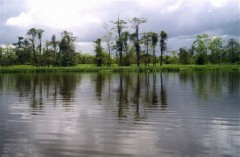
Address: Agusan del Sur
Description: Known as the home of record-setting Lolong, the saltwater crocodile (Crocodylus porosus) that earned the distinction of being the world's largest captive crocodile to date, the Agusan marshland is one of the most significant wetlands of the country. Acting like a sponge, the site contains almost 15% of the country’s freshwater resources in the form of swamp forests.
Status: Newly Opened
| Protection Status |
|
| Area |
|
| Bio-geographic Features |
|
| Flora |
|
| Fauna |
|
| Livelihood Resources |
|
Agusan Marsh is surrounded mostly by agricultural lands. Mine operatiosn in the headwater create receptacles and serve as carriers of silt, fecal materials, mine tailings, and other harmful wastes. This damages water quality, and heavy siltation disturbs the ecosystem.
Talacogon's three barangays within Agusan Marsh has a total of 6,500 residents, 95% of whom belong to the Manobo tribe (within the Ancestral Domain Sustainable Development Protection Plan [ADSDPP] Loreto). The leadership system among Manobos rest in the elders, called Manigaon. They manage community affairs, ensure peace, and engage with other communities. The Manobo spirituality and beliefs reflect their profound ties to the land and its resources.
Municipalities claim jurisdiction over the marsh. In the Municipality of Loreto, the marshland is part of ancestral domain (Certificate of Ancestral Domain Title or CADT 090). There is a critical need to harmonize the NIPAS act and the IPRA law in the management of the marsh.
| Date | Project | Proponent |
| 2016 | Agusan Marsh Conservation Management Plan Review & Polishing | FPE Mindanao Regional Unit |
| 2016 | Agusan Marsh Conservation Management Plan Presentation & Commitment Building | FPE Mindanao Regional Unit |
| 2015 | Agusan Marsh Stakeholders Conservation Management Planning Workshop A key preliminary step in the creation of a conservation management plan for the marsh, and the creation of a Technical Working Group to facilitate the polishing and implementation of the plan |
FPE Mindanao Regional Unit |
| 2012 | Research and Socio-Economic Assessment of Agusan Marsh Wildlife Sanctuary | Mindanao State University Naawan Foundation for Science and Technology Development, Inc. (MSUN-FSTDI) |
Kalikasan BCSD Knowledge Series Twenty-One - Tales of the Manobos: Agusan Marsh, 2016. Foundation for the Philippine Environment.